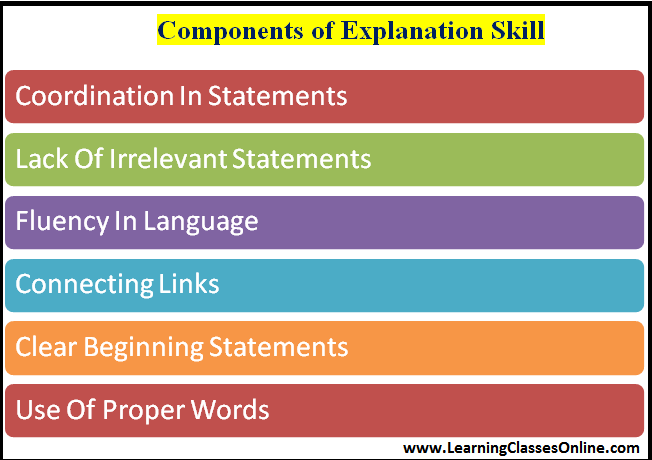
Skill of Explanation in Micro Teaching
The Skill of explanation in micro teaching involves explaining a concept to your audience. It includes using simple and relevant examples, avoiding irrelevant statements, and giving adequate time for students to grasp the concepts.
Feedback is a critical aspect of micro teaching and can be provided through students, peers, supervisors or even by video-tape. It enables teachers to understand what works and what doesn’t.
Clarity
In micro teaching, teachers are asked to teach a short lesson or piece of information to a group of students or colleagues and receive detailed feedback on their presentation and style of instruction. The micro teaching procedure is a highly effective way to train teachers and provide them with the tools they need for real classroom teaching.
The ability to communicate ideas clearly is an essential skill for micro teaching. This involves using clear and concise language, as well as avoiding vague or confusing statements. Teachers should also use transition words, such as ‘therefore’, ‘furthermore’, and’so’, to consolidate statements into a coherent sequence for better comprehension.
The micro teaching process usually involves the following steps: The teacher trainee will be given a demonstration of the skill that they need to practice, such as clarity in explaining. They will then prepare a lesson on the topic of their choice, which they will then present to the group of other teachers and TATP facilitators. The instructor will then receive verbal feedback on the quality of their explanation and will re-teach the class if necessary.
Continuity
A teacher needs to explain the concepts in a way that they are understood well. This is possible by providing logical and interesting examples which are relevant to the topic. The explanation is also effective if it provides closure to the topic.
The teaching skill of explaining entails describing the ‘why’, ‘how’ and sometimes the ‘what’ of a concept, principle or phenomenon. It is a way of filling the gap in understanding that may occur during the learning process.
Micro teaching is a method in which a trainee teacher practices a single teaching skill at a time. This is done by reducing the class size, and by selecting a specific subject to teach. The trainee then prepares a lesson plan, teaches it to students in a simulated classroom setting, and then receives feedback from supervisors on their teaching performance. The ‘teach-re-teach’ cycle is repeated until the trainee achieves mastery of the selected skill. The technique has a number of limitations. For example, it is not a good way to develop creativity in teachers. In addition, it may be difficult to obtain instant feedback.
Relevance
The skill of illustration with example is a crucial part of micro teaching. It involves the use of relevant and interesting examples to increase the student’s understanding of the subject taught. If done correctly, it can also stir up emotions and reach the conscience and heart of students. It is a powerful and effective tool that teachers should always make use of.
Using this technique, you can break down complex content into simpler points and incorporate transition words such as ‘therefore’, ‘furthermore’,’so’, etc. This will help the students to understand your statements more clearly and avoid confusion. You can also use analogies and metaphors to explain the concept.
The micro-teaching technique provides a low-risk environment for aspiring teachers to practice their skills in a controlled setting. As a result, trainees can receive immediate feedback on their performance and modify their classroom behavior accordingly. This makes the training of teacher-trainees much more individualized than other methods. Moreover, micro-teaching allows teacher-trainees to work on specific teaching behaviours without the fear of causing real damage in a classroom environment.
Repetition
The ability to repeat information, either verbally or written, is an essential element of learning. For example, young children learn to read through repetitive reading and imitation of their parents. Similarly, they learn the alphabet and recall facts through repeated practice. However, mere repetition without careful planning does not lead to useful learning.
Planned repetition is a technique that involves reinforcing a concept several times over a course of days or weeks. This strategy allows students to absorb critical information at a pace that matches their processing abilities. It also prevents learners from becoming bored with the same topic, which can lead to a loss of interest in a subject.
In a recent study, we found that grade repetition was common across all levels of primary school in Ghana. Moreover, students who were repeatedly held back in class often dropped out of school altogether. We propose that a combination of factors including the student’s confidence, relationship with their guardian, and outlook on life affects grade repetition rates.
Examples
In the Micro teaching method, student teachers are taught to use different teaching techniques by practicing on small groups of students. This allows them to improve their teaching skills before they are put in a real classroom. It also helps them to avoid common mistakes that can happen in a classroom. It is important to give clear and concise explanations. This is especially important if the topic is new or complicated. Using examples from everyday life can help your pupils to understand the topic better.
The built-in feedback mechanism in the micro teaching method is essential to teacher-trainees as it enables them to evaluate their attempts to imitate certain patterns of teaching. This feedback may be provided by the supervisor, video-tapes or closed circuit television. It also identifies the shortcomings of a student teacher and helps him rectify them.
The student teacher teaches his micro lesson to another group of comparable students and then the supervisor observes it. After this, the student teacher re-plans his lesson and teaches it again. The process is repeated until the student teacher reaches a level of mastery in his teaching.


